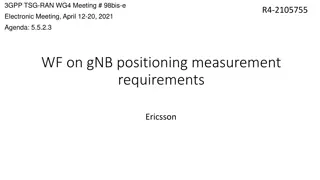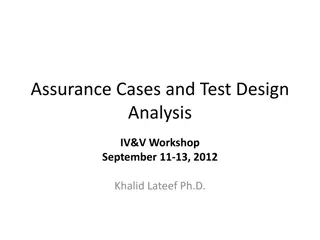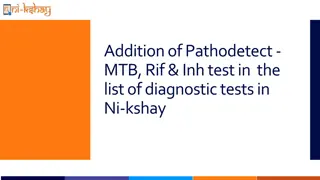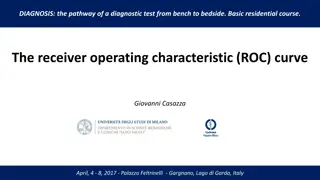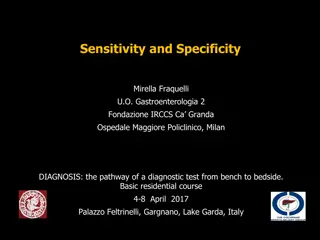Diagnostic Test Accuracy Study: Design and Implementation
This content delves into the pathway of a diagnostic test from development to clinical application, focusing on the basic concepts of diagnostic test accuracy, study design, the 2x2 table, and key terminology. It discusses the importance of study design in assessing diagnostic accuracy, including factors such as patient selection, blinding, thresholds, time intervals, and statistical analysis. Various case examples are presented to illustrate different study designs in evaluating the accuracy of diagnostic tests.
Download Presentation

Please find below an Image/Link to download the presentation.
The content on the website is provided AS IS for your information and personal use only. It may not be sold, licensed, or shared on other websites without obtaining consent from the author. Download presentation by click this link. If you encounter any issues during the download, it is possible that the publisher has removed the file from their server.
E N D
Presentation Transcript
Outline DIAGNOSIS: the pathway of a diagnostic test from bench to bedside. Basic residential course. Diagnostic test accuracy. Study design and the 2x2 table Giovanni Casazza April, 4 - 8, 2017 - Palazzo Feltrinelli - Gargnano, Lago di Garda, Italy
Outline Design of a diagnostic test accuracy study Summary of the results: the 2x2 table Interpretation of the results: true and false results
Terminology Index test (test under evaluation) Reference standard (previously gold standard ) Target condition (disease of interest) Key points of the diagnostic accuracy assessment procedure: Study design: setting and patients selection modality (consecutive? inappropriate exclusions?) Technical characteristics of the two tests Blinding Same reference standard for all the participants Threshold (predefined?) Time interval between index and reference (appropriate?) Statistical analysis (appropriate? participants excluded from the analysis?)
Study design The aim of a diagnostic accuracy study is to evaluate the association between the index test results and the disease status of the study participants. + _ Index Test
Study design Study design: case-control Index test: AFP Target condition: HCC Reference standard Two samples No HCC (controls) HCC (cases)
Study design Index test: Platelet count Target condition: Esophageal varices Reference standard: Upper gastrointestinal endoscopy Participants included: only people with Child-A HCV Cirrhosis
Study design Index test: Platelet count Target condition: Esophageal varices Reference standard: Endoscopy Patients selection Inclusion/exclusion criteria Index test Reference standard
Study design Study design: cross-sectional with consecutive patients selection The index test and the reference standard are perfomed at the same time. Index test: Platelet count Target condition: Esophageal varices Reference standard: Endoscopy + + Diseased - Plt count Endoscopy + - + Not diseased - - One mixed sample All patients suspected of having the target condition. - +
Diagnostic tests When using a diagnostic test in clinical practice we would avoid errors (misclassification of patients). A perfect index test. All diseased individuals have a positive test result. All non-diseased individuals have a negative test result. Unfortunately this happens only in an ideal world. In the real world the result of an index test may sometimes be wrong. We have to deal with false results.
Results of the study Summary of the results of a diagnostic test accuracy study The 2x2 table
The 2x2 table What is the 2x2 table? It is a cross tab. Built by crossing index test and reference standard results. It is a summary description of the study participants. Reference Standard Index Test Capsule endoscopy for the diagnosis of esophageal varices Results: Results: 51 pts had a + IndexTest and a + ReferenceStandard 20 pts had a IndexTest and a + ReferenceStandard 48 pts had a IndexTest and a ReferenceStandard 0 pts had a + IndexTest and a ReferenceStandard 0 pts had a + IndexTest and a ReferenceStandard 51 pts had a + IndexTest and a + ReferenceStandard 20 pts had a IndexTest and a + ReferenceStandard 48 pts had a IndexTest and a ReferenceStandard
The 2x2 table What is the 2x2 table? It is a cross tab. Built by crossing index test and reference standard results. It is a summary description of the study participants. Reference Standard Index Test Capsule endoscopy for the diagnosis of esophageal varices Results: Results: 51 pts had a + IndexTest and a + ReferenceStandard 20 pts had a IndexTest and a + ReferenceStandard 48 pts had a IndexTest and a ReferenceStandard 0 pts had a + IndexTest and a ReferenceStandard 0 pts had a + IndexTest and a ReferenceStandard 51 pts had a + IndexTest and a + ReferenceStandard 20 pts had a IndexTest and a + ReferenceStandard 48 pts had a IndexTest and a ReferenceStandard
The 2x2 table What is the 2x2 table? It is a cross tab. Built by crossing index test and reference standard results. It is a summary description of the study participants.
The 2x2 table What is the 2x2 table? It is a cross tab containing four (2x2=4) numbers. These four basic numbers carry all the information needed. Reference Standard Four cells Two rows Index Test Two columns
The 2x2 table TP FP Index Test FN TN TP: True Positives FN: False Negatives FP: False Positives TN: True Negatives The 2x2 table contains all the information needed for a quantitative assessment of diagnostic accuracy. Accuracy how many times was the result of the index test right ? 51+48=99 99/119=83% Inaccuracy how many times was the result of the index test wrong ? 20+0=20 20/119=17%
Take home points Optimal study design: cross-sectional with consecutive patients selection The 2x2 table contains all the information needed to assess the diagnostic accuracy. The overall accuracy is a rough estimate of the accuracy of an index test: false positives and false negatives are assumed to have the same importance. A combined evaluation of true(false) positives and true(false) negative is needed for a correct assessment of the diagnostic accuracy












